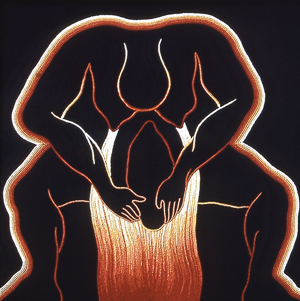The Ming Dynasty in China spans the years 1368-1644 and was a time of revival for the arts. Well-known for their elaborate pottery, the Ming artists also created beautiful ink paintings. Typically about nature subjects, they appear at first rather simple until you look at all the individual brushstrokes that make them up. There were many different art styles during this time, pitting traditional court painters against emotive scholars, but I will concentrate on ink painting in general. The art subjects often symbolize a spiritual message, and require the viewer to think.

Dragon Pine is an ink painting done by Wu Boli circa 1400. Wu Boli was a Daoist priest, so it is no surprise that the tree represents a moral message. The pine represents strong moral character, growing tall and strong. Here, nature is a stand-in for man. Although the painting is not colorful and is simple in its subject matter, I really like it. Using only varying shades of black, the artist manages to convey a sense of light and shadow. The tree itself looks very magnificent, like a man with good moral character is supposed to look like. 
Two Hawks in a Thicket is estimated to have been completed mid-1400s by Lin Liang, a court painter who specialized in bird paintings. Hawks represent heroism and these hawks manage to look grand even though they are simply sitting in a tree. Again, this is a pretty painting. The subject matter is not that interesting to me, but I admit that the work is very realistic and no doubt took a lot of technical skill.

Lastly, we have Bamboo in Wind by Xia Chiang, completed ca. 1460. Like many scholars and court officials of the time, Chiang dabbled in art. Bamboo is a common theme in Chinese art not only because it is plentiful in the country but also because it represents strength. Here, the bamboo stays strong in the wind. This relays a message to the viewer that they should remain strong even in the face of adversity. Although the bamboo leaves are simple, the way the varying shades gives depth to the painting is nice. Artists like Chiang prove that art does not need to be complex or emotional to be beautiful and meaningful.
Conclusion
The ink art of the Ming dynasty showcases a long tradition of Chinese art. Instead of showing stories to teach moral lessons, the Ming artists relied on nature to showcase wisdom. The beauty of the art is why it has survived over the years and remains popular.
“Bamboo in Wind.” Metropolitan Museum of Art. Accessed 23 Nov. 2016.http://www.metmuseum.org/toah/works-of-art/1989.235.1/
“Dragon Pine.” Metropolitan Museum of Art. Accessed 23 Nov. 2016.http://www.metmuseum.org/toah/works-of-art/1984.475.3/
"Ming dynasty 1368–1644." Princeton University Art Museum. Accessed 23 Nov. 2016. https://etcweb.princeton.edu/asianart/timeperiod_china.jsp?ctry=China&pd=Ming
“Two hawks in a thicket.” Metropolitan Museum of Art. Accessed 23 Nov. 2016.http://www.metmuseum.org/toah/works-of-art/1993.385/





